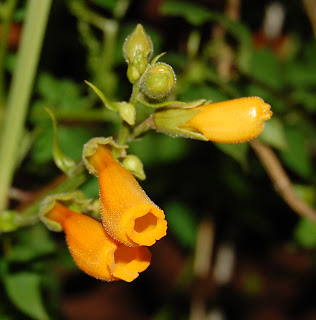This second (part one is here) and final part about our climbers kicks off with a very hardy Clematis....
Personally, I'm not a great lover of Clematis, but this one has always been there (hence, I don't know it's name), but it blooms prolifically in the early summer. The flowers are about 60/70mm in size.
Rhodochiton atrosanguineum (Purple Bell vine) is far too tender to survive outside in the UK winter. The good news is that it usually makes it through if placed in an unheated garage, shed or greenhouse and kept dry. It's also very easily grown from the seeds that it produces plenty of.....
I'm lucky enough to have three Sollya heterophylla, two in blue and one of the white form. Sollya is the old name, the "new" one being Billardiera heterophylla (why do they have to keep doing this). The common name is Bluebell Creeper.....
This has a vigorous growth habit, but once again is too tender for our winters. Mine come into the conservatory for the winter where they continue to grow well. But, and it's a big but, they're very susceptible to the dreaded red spider mite.
Eccremocarpus scaber (Chilean Glory flower) is thought of as tender over here, but I've always found it to be anything but! Another plant which is very easily grown from the masses of seeds that it produces.
If it has one drawback, it is that it grows very quickly indeed and will need to be trimmed or tied up as you require on a regular basis.
Here in the UK, Gloriosa superba is thought of as an exotic, which seems odd to me as it's so easy!
Chuck the tubers into fresh soil (in a pot) March time, water in and place in the conservatory or greenhouse. Give it something to climb up, water only as it gets to the point of starting to wilt and that is it. I withdraw water in September and allow it to dry out fully, before putting it in a cupboard for the winter and repeating the whole process again the following spring.
Hopefully, this time next year I should have a few more to show off. I have some Allamanda seeds on the way, hopefully Plumbago too. And in January, a friend is off to India and has promised to return with some Thungergia grandiflora seeds. I can't wait!









Hi Keith, Rhodochiton seed is easy? Not for me :-( I have the privilege to have some. They are so tiny and I find it hard to handle. Also, I failed in a number of attempts to germinate the seeds. Please give me some tips. I have three tiny seeds left only to try for one last time. Thanks in advance! All your climbers are fantastic :-D
ReplyDeleteSteph - you've picked a flaw in my text! It is also something that puzzles me too. Your seeds are bought seeds, which are so small that they come in a little plastic vial. I too (and everyone that I've spoken to) get a very low rate of germination with these.
ReplyDeleteThis is how I do it;
Put compost and perlite mix into a pot, leaving 15/20mm of space at the top.
Top up with more compost that you have run through a sieve to the top of the pot.
Stand this in a bowl and fill the bowl with warm water. The water level should be at the same level roughly as the soil level.
Remove from the water - the very fine layer of compost at the top should sink down. Sow these seeds on the surface.
I put mine into a heated propagator. In your climate they should be ok in a window, maybe with a clear plastic bag over them to stop the top of the soil drying out.
Once you have your own plants and have collected seeds from them, you will see that the seeds are nearly as large as a chilli seed with the outer husk on them. From these you should get a near 100% rate of germination. The seeds that we buy have the outer husk removed, and for whatever reason, this appears to affect the seeds viability.
Hope that this helps!
Eccremocarpus scaber is on my wish list for next year, maybe I'll try growing some from seed, especially if I can find a couple of different colors. thanks!
ReplyDeleteIt's very easy to grow from seed Ryan. IMHO though, the red variety is disappointing in terms of the colour. But that is just my opinion, although I like reds, and as a rule, don't usually go for orange flowers. The yellow isn't bad though....
ReplyDeleteThanks Keith! I appreciate the detailed explanation very much :-D I am going to try again.
ReplyDelete